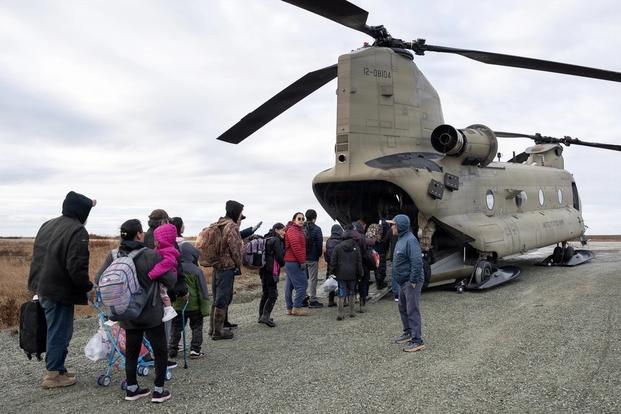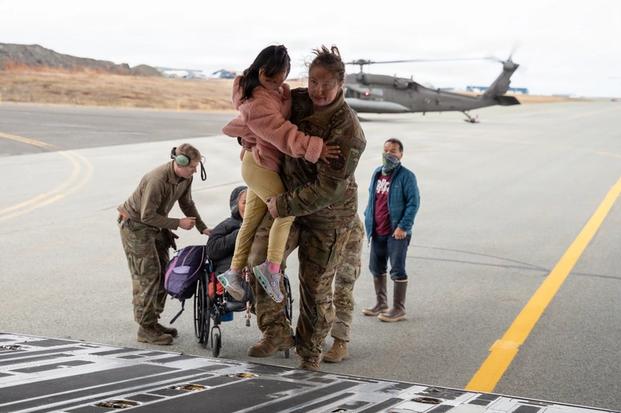When the remnants of Typhoon Halong roared into western Alaska in October 2025, the storm brought hurricane-force winds, heavy flooding, and the worst coastal surge in decades. Entire homes in the Yukon-Kuskokwim Delta were swept from their foundations, power and water systems failed, and hundreds of residents were left stranded in remote villages only accessible by air. Within hours, Alaska’s government, the National Guard, and federal agencies launched what became one of the largest airlifts in the state’s history, moving hundreds of displaced residents to safety.
The Scale of the Evacuation
Kipnuk and Kwigillingok, two coastal villages in the Yukon-Kuskokwim Delta, were hit hardest. Water levels surged over six feet above normal high tide, breaking long-standing flood records. Entire neighborhoods were submerged, and many homes became uninhabitable. Local shelters quickly filled, forcing officials to coordinate an emergency airlift to Anchorage and Bethel. Over two days, more than 600 residents were flown out aboard military and chartered aircraft, including Alaska Air National Guard C-17 Globemaster III. The operation, according to state emergency officials, ranked among the largest mass air evacuations ever conducted within Alaska.
Moving People and Supplies Under Extreme Conditions
The logistics of the mission were formidable. Many airstrips in the region were flooded or covered in debris, forcing pilots to rely on short gravel runways and minimal visibility. Alaska Army National Guard helicopters and smaller fixed-wing aircraft first shuttled evacuees from villages like Kipnuk and Kwigillingok to Bethel and other regional hubs. From there, Alaska Air National Guard C-17 Globemaster III transport planes carried larger groups onward to Anchorage. At Joint Base Elmendorf-Richardson, temporary shelters had been prepared with the help of the American Red Cross. Each flight also delivered emergency cargo, including food, fuel, medical kits, and water filtration systems, to isolated communities still cut off by floodwaters. The coordination between military units, state agencies, and local volunteers demonstrated a rare level of rapid-response integration under extreme pressure.
Coordination Across Federal and State Lines
The Federal Emergency Management Agency activated a regional response coordination center and sent staff to Alaska, embedding liaisons and mass-care specialists at the State Emergency Operations Center in Anchorage to support the storm response. The state’s transportation department deployed multiple unmanned-aircraft teams to map damage, collect data, and support assessments in hard-hit villages. As evacuations moved people from Bethel to Anchorage,
Shelter operations were stood up and managed jointly with state and local partners, with two large shelters operating in the city and additional non-congregate options identified. After President Trump approved a major disaster declaration for Alaska, FEMA should soon begin coordinating longer-term recovery with the governor’s office and the Alaska Division of Homeland Security and Emergency Management. The American Red Cross also deployed hundreds of disaster volunteers to support evacuees in Anchorage and other hubs.

Damage, Displacement, and the Human Toll
More than 1,500 people were displaced across the western coast, most of them Indigenous Alaskans. At least one fatality was confirmed, and several residents were reported missing in the aftermath. The National Weather Service reported peak gusts above 100 miles per hour and described Halong’s surge as the most destructive coastal flooding in western Alaska since the 1970s.
From Response to Recovery
As airlifts tapered off, the focus turned toward rebuilding. Temporary shelters in Anchorage and Bethel continued housing evacuees while federal disaster-aid teams assessed long-term needs. Governor Mike Dunleavy formally requested federal assistance, which was approved within days, unlocking tens of millions of dollars for reconstruction and recovery. Initial assessments by Alaska’s emergency-management division found that over 90 % of structures in Kipnuk and about 35 % in Kwigillingok were destroyed by the storm. Relief efforts also included the deployment of engineers to restore airstrips and power systems before the onset of winter.

The Airlift That Redefined Readiness
For Alaska’s National Guard, the Typhoon Halong airlift was not just a rescue mission but a test of capacity in one of the most remote regions in the United States. The operation proved that large-scale air mobility and coordination with local governments can save lives even in extreme conditions. It also serves as a warning of what risks dangerous storms pose to isolated communities. The people of the Yukon-Kuskokwim Delta now face the long task of rebuilding, but the record-setting airlift stands as evidence of both Alaska’s vulnerability and its ability to respond when the stakes are highest.
Story Continues
Read the full article here


25 Comments
600 people evacuated in two days—must have been chaotic. How did they prioritize who to move first?
Good point. Vulnerable groups like elderly and children likely got priority, but details on that are scarce.
Bethel and Anchorage must have been overwhelmed. How are they handling the influx of displaced residents?
Shelters and temporary housing are being organized, but resources are stretched thin.
Surprised to see such extreme flooding in Alaska. How are they planning to rebuild in areas prone to this now?
Great question. Relocation or elevated housing may be the only options. The costs will be significant.
The scale of the evacuation speaks volumes. It’s a miracle no lives were lost.
True, but the aftermath will be challenging. The focus now should be on long-term solutions.
The National Guard’s involvement shows the severity of the situation. Hope the relief efforts continue.
It’s a team effort, and long-term support will be necessary.
Flooding over six feet above high tide? That’s shocking. How often do storms like this hit Alaska?
Unfortunately, more often as polar ice melts and sea levels rise.
This kind of disaster could happen anywhere, but remote areas are especially at risk. Are other regions preparing better?
Some are, but many aren’t. Budget and resources are often the limiting factors.
This reminds me of how vulnerable remote Alaskan communities are to extreme weather. Better infrastructure might be needed.
Definitely. Climate change is only making these storms more frequent and severe.
Fast response time for an emergency of this scale. The coordination between state and federal agencies clearly paid off.
It’s a good example of effective emergency management in action.
Heartbreaking to see entire neighborhoods submerged. The economic and emotional toll must be immense.
Absolutely, and the recovery will take years. Not just rebuilding homes, but lives.
That’s incredible. The logistics of evacuating 600 people in just two days during a disaster is impressive. Hope the displaced residents get the support they need.
Absolutely. It’s a testament to resilience and coordination. Local communities must be struggling, though.
Yes, and the long-term recovery efforts will be just as critical as the immediate response.
Disasters like this highlight the need for stronger climate policies. Hope this becomes a wake-up call.
Yet another example of how unprepared many regions are for climate-related disasters.